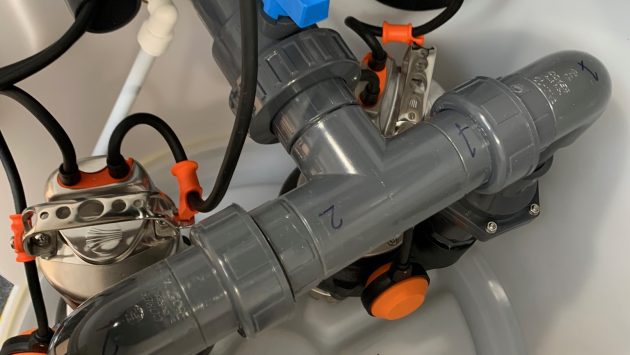How to Pump Water Out of a Flooded Basement
If water finds its way into your basement, whether it’s a result of natural rain flow, plumbing issues or sewage failures, it’s crucially important to remove the water as fast as possible.
But how are you meant to do that? Our experts have crafted this guide to help you understand what you need to do in the case of a flooded basement, walking you through it – step-by-step.
Types of pumps for basement water removal
Submersible pumps
These types of pumps are designed to be submerged in water. Their function is to remove large volumes of water quickly and they do this well. They are often used for heavy-duty drainage in basements and sewage systems.
Sump pumps
Sump pumps differ from submersible pumps because their motor is above water, instead of below. They are often suited to more residential, light-duty drainage so they work well in home basements.
Alternative methods to remove standing water do exist. For example:
- Wet/dry vacuum – Removes standing water by sucking it through a hose. Remember to empty the tank regularly.
- Bucket and a mop – If there is a small volume of flooding, this budget-friendly, but labour-intensive, option will take time but can be helpful for small amounts of water.
However, a pump will efficiently remove water from a basement in less than 2 days, saving time, reducing manual effort, and minimising the risk of further water damage or mould growth.
How to pump water out of your flooded basement
If you have large amounts of water in your basement, a water pump is often the best solution. Here’s how to remove the flood water using one:
-
Turn the power off
Before entering the flooded basement, turn off the power. This ensures that you won’t get a surprise shock from electricity and can stay safe while removing the water.
-
Assess the damage
Determine the cause of the flood and if it has stopped. Is it a plumbing issue? Could it be a sewage or septic tank failure? Has it rained too heavily for your home to withstand? Find the issue and this will help you decide a plan of action.
-
Choose a water pump
Choosing which water pump to use mainly depends on the depth of the water. For deeper levels, a submersible water pump is likely to work most efficiently, as they are designed specifically to function underwater. On the other hand, a sump pump automatically activates when water levels rise. They are an impressive and effective machine to prevent future flooding.
-
Set up the pump
No matter which water pump you utilise, the pump should be placed at the lowest point of the flooded area. For submersible pumps, ensure the whole pump is submerged. As for a sump pump, it should be stood firmly on a solid, level surface.
Attach the hose to the pump and direct it away from your home’s foundation, ideally towards a drain.
-
Remove standing water
Turn on the pump and steadily begin draining the water. Monitor how the water level decreases. You might have to place the pump in a different position depending on how the water moves.
If you’re overly cautious about maintaining your home’s foundations, you can wait 24 hours after pumping some of the water out of the basement to test if the level remains the same or rises. If the level stays the same, you can continue the next day to remove the rest of the water. This gradual approach can help prevent structural damage.
It’s also important to check for debris and dirt that risk clogging up the pump.
How to dry out the basement after water removal
Dehumidifiers
Fans and dehumidifiers will remove excess moisture from the air. This will aid the drying process and help reduce the chance of mould growing.
Windows and fans
Open basement windows (if possible) to draw fresh air into the room. Try and keep doors throughout the home open too, as this will create circulation that will speed up the drying process. Don’t forget to close the windows overnight.
Check for mould
It’s important to check for mould growth after a basement flood as it has the potential to continue growing. It can critically damage the foundations and safety of the building.
Remove wet materials and items that were affected by the flooding and only return them once they are cleaned. Damaged flooring and drywall/insulation may be best to replace entirely.
How to prevent future basement flooding
- Perform regular maintenance – By conducting regular inspections and checking that the basement is well-built with appropriate drainage systems, you can prevent water from flowing into the basement. You’ll also be able to spot any signs of weaknesses before water can affect them and cause serious issues.
- Improve exterior drainage – Direct the flow of water away from your home. You can do this by ensuring that gutters and drainage systems are functioning properly and, again, facing away from the home.
- Install a sump pump system – A professionally installed sump pump will ensure that your basement doesn’t flood. The pump – located in the lowest point of the basement – automatically activates when water reaches a certain level. It also uses a battery backup system to ensure your pump continues working even during power outages.
How Sumps and Pumps can help
Handling a flooded basement can be an overwhelming task, but not if you have the right resources. With a sump pump, you can easily remove water while prioritising safety and efficiency.
If you’d like to know more about sump pumps, you can view Sumps & Pumps’ range of easily installed basement and cellar sump pump packages here.
If you have any questions or enquiries, please get in touch for a chat with our friendly team! Sumps and Pumps have been supplying top-quality sump pump machinery for years at competitive prices – we’re here to help.



